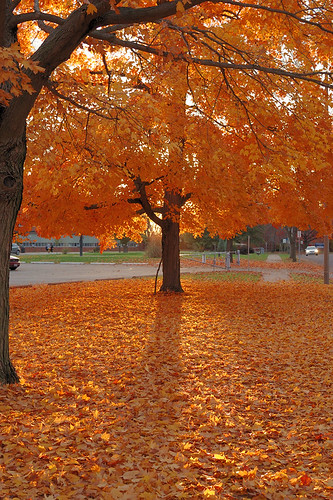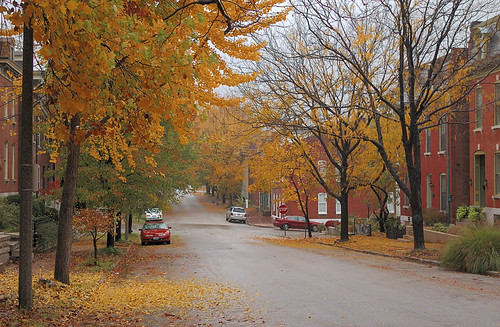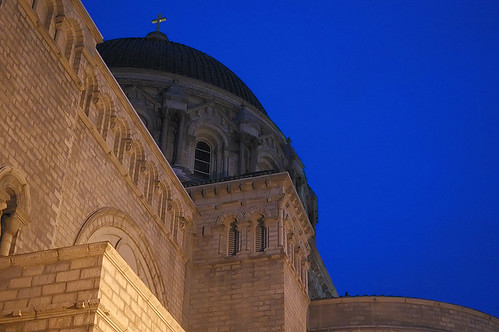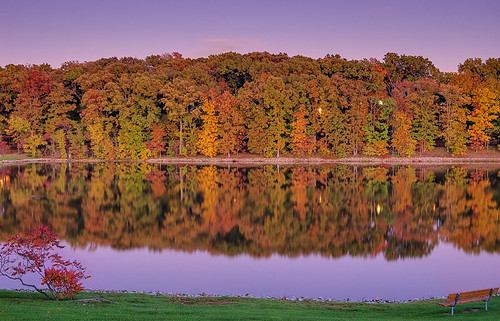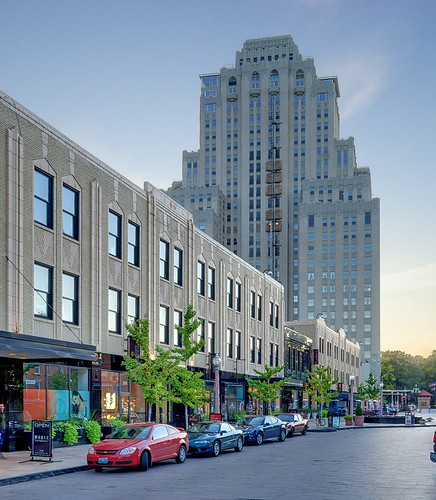
Saturday, October 31, 2009
“Public Enemy Number One”
But the German philosopher Dietrich von Hildebrand (1889-1977) pointed out that a government of moral relativists is necessarily totalitarian, and will impose its moral views on others with force. His early opposition to the National Socialists made this scholar “public enemy number one” of that totalitarian German regime.
Yesterday I posted a short article on von Hildebrand; and after this I heard an interview of Dietrich's wife Alice on EWTN. (This interview is online, although I can't directly link to it, you can search for it here. Look for the date 10/28/2009). Alice is involved with the Dietrich von Hildebrand Legacy Project, which is seeking scholars willing to translate von Hildebrand's works from German into English.
Friday, October 30, 2009
“Debating Beauty: Jacques Maritain and Dietrich von Hildebrand”
JACQUES MARITAIN'S BOOK Art and Scholasticism sometime seems to be the last word in the Catholic philosophy of art, and by “last” I mean that it often is quoted as the most recent authoritative book on the subject (although of course, it is not). The author's final edition of the book came out in 1935. Although it is an excellent book, it eventually comes out in favor of the modernistic side of the arts, which subsequent experience has proven disastrously wrong.
Philosopher Alice von Hildebrand discusses the artistic debate in the article Debating Beauty: Jacques Maritain and Dietrich von Hildebrand. She asks:
Is aesthetic appreciation a question of taste, as one can like or dislike beer? Tastes cannot be debated, and such debates would be totally meaningless.Dietrich is Alice's late husband, a Catholic convert, philosopher, and one of the first public intellectuals who denounced National Socialism in Germany in the early 1930s. Pope Benedict said of him: “When the intellectual history of the Catholic Church in the twentieth century is written, the name of Dietrich von Hildebrand will be most prominent among the figures of our time.” She continues:
Whereas for Maritain, sense experiences are purely human, both Newman and von Hildebrand claim that though man's senses are necessarily involved, the message they communicate radically transcends the world of pure matter. It transmits a message coming from above, some mysterious echo of "the eternal hills" that sharpen our longing for Beauty itself -- that is, God.Art matters, and it is not the exclusive property of our “social conditioners” in the media, government, and education, which we must passively receive. Indeed, according to Catholic philosophy, everything made by the hands of man is art, and all art is bound towards judgement.
On the Theme of Hallowe'en
- G. Thomas Fitzpatrick at Recta Ratio has a tradition of fine Hallowe'en postings, which can be seen here.
- Hilary Jane Margaret White discusses views of the supernatural and cosmology seen in recent popular fiction here. Oddly enough, Mormon cosmology is often depicted in popular fiction, a worldview greatly different from orthodox cosmology.
- Fr. John Zuhlsdorf comments on an article on an exorcist here. There are many interesting comments to this article, and Fr. Z offers us some warnings regarding this matter.
- Msgr. Charles Pope of the Archdiocese of Washington offers some advice on the celebration of Hallowe'en here.
The Saint Louis University Exorcism of 1949
But as it happens, actual demonic possession is very rare. The contemporary church greatly values the work of scientific psychology, and many exorcists have training in psychiatry. These phenomena are indeed psychological, but what is the psyche, and what is the nature of reality in which our psyches inhabit? According to exorcists, while demonic possession is very rare, demonic obsession is distressingly common, and is becoming more frequent. Saint Michael the Archangel, defend us in battle!
The lurid Hollywood film The Exorcist was very popular when I was attending Lutheran Sunday school, and the students questioned the pastor about that. He told us that we had to “go to the Catholics” for exorcism. As it happens, The Exorcist was very loosely based on events that happened in Saint Louis in 1949, and in that case, the Lutherans indeed referred this matter to the Catholics.
I assume this screening is in the hall beneath the church. As I haven't seen the video, I don't know its content. However, the subject of demonology ought not be taken lightly, and we should in general be not curious of such matters; in fact, exceptional holiness is needed for those involved to avoid harm.
Thursday, October 29, 2009
My Business Card

With the great success of the book Catholic St. Louis: A Pictorial History, I get many requests for photography. So, now I'm making it official.
Please send me an email with your requirements, and I'll get back to you with a quote.
I can also teach digital photography and Photoshop according to my methods.
As weddings require many special considerations, I will refer the main photography to another professional who specializes in weddings, but I will attend as an auxiliary photographer.
Wednesday, October 28, 2009
Fall Color
REMINDER - Paul, Duke of Oldenburg, at the Oratory

PRESS RELEASE
INSTITUTE OF CHRIST THE KING SOVEREIGN PRIEST
St. Francis de Sales Oratory
Contact: Canon Michael K. Wiener, Rector
(St. Louis, MO, October 2008) – St. Francis de Sales Oratory is pleased to announce the visit of His Highness, Paul, Duke of Oldenburg, to the Oratory on Saturday, October 31, 2009. An inspiring speaker on various topics related to the Faith, His Highness will give a talk on “The Importance of Tradition” at 2:00 p.m. in the Oratory hall. A reception in the hall follows the talk.
A descendant of Queen Victoria and Czar Alexander II, Paul, Duke of Oldenburg, is a long-time friend and supporter of the Institute of Christ the King Sovereign Priest. In his native Germany, he is involved in a variety of political and social activities to promote the cause of family values in society. The Duke is married, and father to four young children.
Born in 1969 of one of the oldest Protestant royal lineages, His Highness converted to the Catholic Faith in 1999, and was received into the Church in Rome that year. It was the beauty of the traditional form of the Latin Mass that first brought him to explore the Catholic Church. Msgr. Schmitz, while still living in his native Germany, introduced the nobleman to this liturgy and instructed him along the way that eventually led him to enter the Catholic Church.
For more information, please contact:
St. Francis de Sales Oratory
2653 Ohio Avenue
Saint Louis, Missouri, 63118
Telephone 314-771-3100
Photos of the Chatillon-DeMenil Mansion
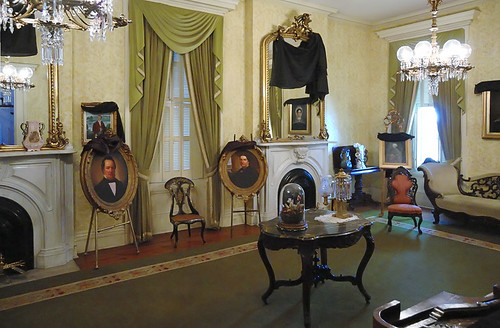
Having a Halloween decorating theme here would both be both ahistorical and tacky. So rather the home is decorated for mourning, which has an appropriate correspondence with Halloween — the eve of All Saints Day — and the month of November, dedicated to the Holy Souls.
This was once a Catholic household. Although specific mourning customs portrayed here derive from the example of Queen Victoria after the death of her husband Prince Albert, certainly many are much older. Black vestments for funerals have long been a part of the Latin Catholic liturgy. The covering of mirrors as seen here is still a part of Jewish mourning custom; covering of images is also found in the Latin church during the end of Lent, a time of mourning for our own sins.
I really hadn't planned on taking photos of this house, so these are basically crude snapshots, which suffer from digital camera noise, overexposed highlights, and poor shadow detail. I also didn't take a photo of the exterior.

A plate, specifically made for times of mourning.
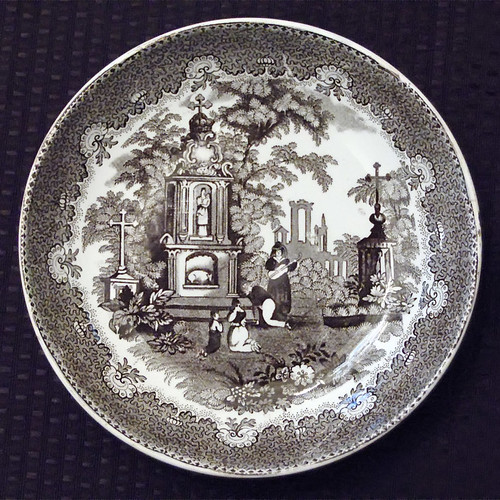
Plate depicting a cemetery visit.
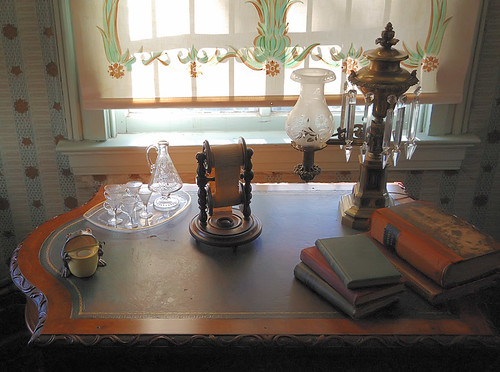
From a history of the house:
The Mansion was built in two sections by families with very different lifestyles. Henri Chatillon built the first section, a four-room brick farmhouse, in 1848. He was a guide and hunter for the American Fur Company of St. Louis in the 1840's before settling permanently in the area with his second wife, Odile Delor Lux. Chatillon served as a guide for Francis Parkman, Jr. in 1846. Parkman wrote about their trip in his book "The Oregon Trail."
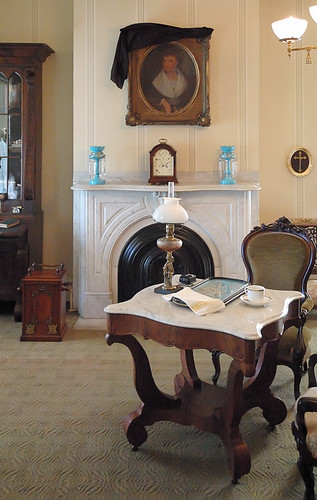
Continuing the history:
Chatillon sold the "farmhouse" in 1856 to Dr. Nicolas N. DeMenil, a well known physician and part owner of the first chain of drug stores in St. Louis. DeMenil was a wealthy Frenchman. He came to St. Louis in 1834 and married Emilie Sophie Chouteau, who was a descendant of St. Louis' founding family. The DeMenils originally used the home as a summer retreat. In 1861, the DeMenils hired English architect Henry Pitcher to add on the extra rooms and turn the farmhouse into a Greek Revival Mansion. At that time they moved into the home permanently. The addition was completed in 1863.This was at the time a wealthy German neighborhood. This class generally believed in industrialization and a strong central government, and their influence greatly shaped the Republic after the War Between the States.
Although the maps call this locale the Marine Villa district, most people refer to it as the Lemp neighborhood. The house sits between the Anheuser-Busch brewery and the former Lemp brewery. In the days before artificial refrigeration, this area was good for brewing because of the cool caves that are found in this area. The style of beer brewed here is called Lager, after the German word for ‘storehouse’, which requires a chilly environment for fermentation and aging.
The historic Lemp Mansion is next door, and it is also open for dining and tours. However, many of the Lemp family unfortunately had unhappy lives and deaths compared to their neighbors.
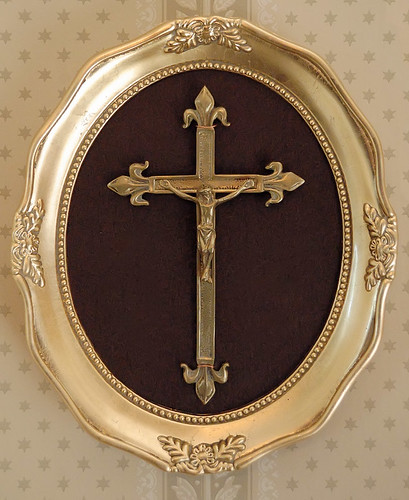
More history:
Three generations of the DeMenil family occupied the home until 1929. From that year until 1945 the Mansion was maintained by caretakers. Lee Hess bought the property in 1945 to develop a tourist attraction based upon the natural system of caves that lie beneath the area. The "Cherokee Caves" were quite popular but the house itself suffered. When Interstate 55 was being planned in the early 1960's the house was going to be torn down. The Landmarks Association decided to buy the land and home from the State of Missouri Highway Commission. They wanted to save the Mansion, because it is one of the only remaining examples of Greek Revival architecture in St. Louis. With a $40,000 gift from Union Electric they bought the house and land. Restoration of the Mansion began in the summer of 1964. Formal dedication of the restored Mansion took place in May 1965. Then the Chatillon-DeMenil Foundation took control of the Mansion.
Structurally, the Mansion today is as the DeMenil family left it in 1929. All the ceiling medallions, marble mantelpieces, front hall parquet foor, and front hall chandelier are original to the house. Most of the furniture is dated between 1830 and 1880, with some original DeMenil pieces. Wallpapers, curtains, and carpets throughout the house are reproductions of original designs.
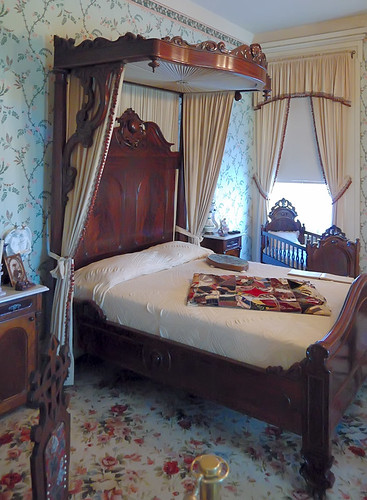
The bedroom of the lady of the house.
Although the owners of the house were wealthy, they did not own slaves. The sharply divided public opinion in the run-up to the American Civil War was reflected within this household. Mrs. DeMenil, descended from the founders of Saint Louis, was in favor of the Southern cause like many of the local French. Her husband, Dr. DeMenil, like many of the newly-immigrated Germans here, had Northern sympathies.
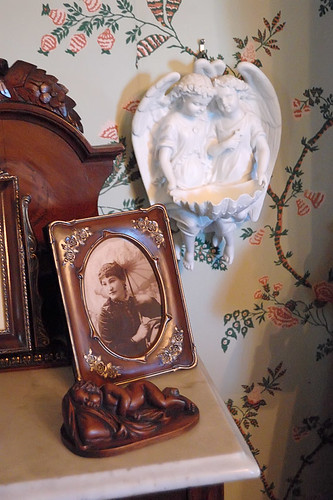
Holy water font next to the bed.
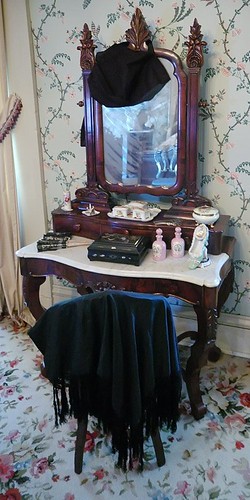
A vanity table.
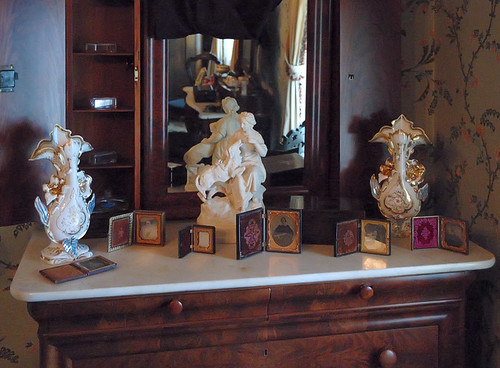
This building is called a mansion, but it is not a particularly large home; it does have a higher level of architectural detail compared to the spacious working-class structures built in the nearby Soulard neighborhood. All these buildings share a feature that once was nearly universal in construction: high ceilings, which are quite helpful in the summer heat. The rooms here are numerous but fairly small.
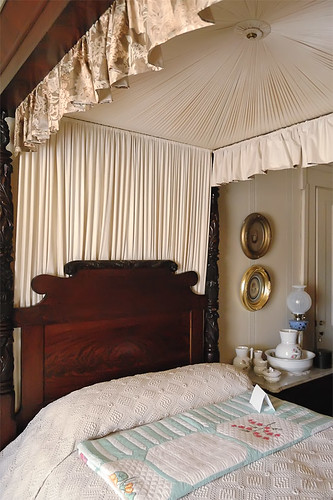
The bedroom of the gentleman of the house. Separate bedrooms for married couples were desirable if they could be afforded. Privacy was always valued. Most particularly, there were no bathrooms, but rather chamber pots were in each bedroom.
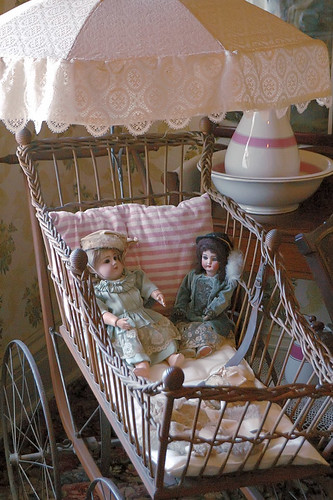
Antique dolls.
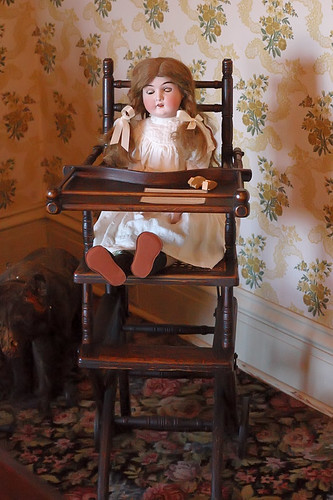
This doll had hair taken from the little girl who owned it.
The ancient custom of keeping relics of loved ones was still quite strong in that period: soldiers who went off to war would leave behind a lock of hair.
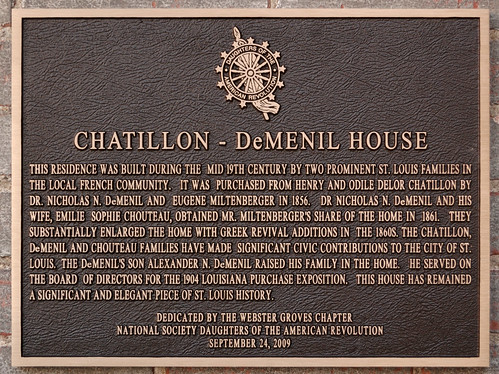
I visited the house on the occasion of the formal dedication of this historical marker by the Daughters of the American Revolution, which featured a Marine honor guard, Pledge of Allegiance, a prayer, and singing of the National Anthem.
Address:
3352 DeMenil Place
St. Louis, MO 63118
Monday, October 26, 2009
Fall Color
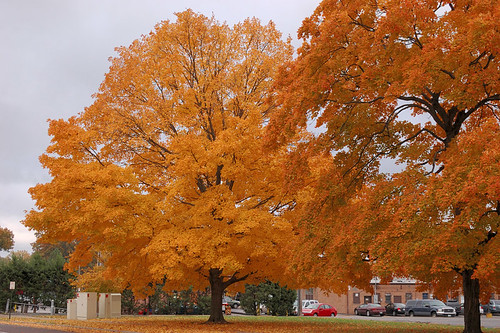
I took these photos three days ago, at about the peak of our fall color. Unfortunately, we haven't had blue skies for a while, so I was only able to get these photos taken during a dark overcast day while it was drizzling.
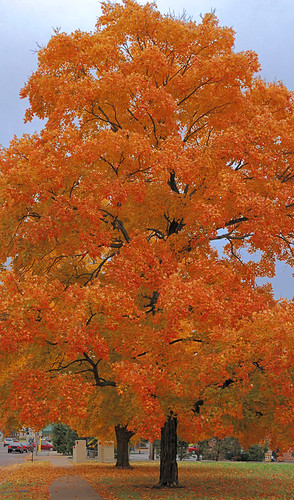
The character of Autumn color varies from year to year. Our colors were very good this year, although there seems to be less red tree color than normal.
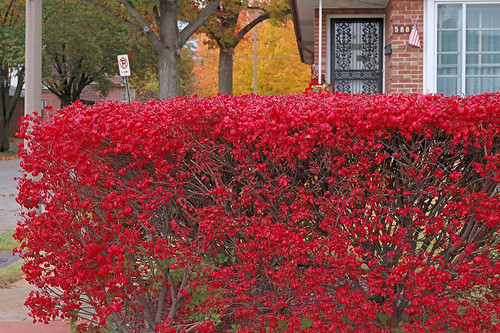
But these bushes are always reliably red.
Friday, October 23, 2009
“Catholic News Live”
http://catholicnewslive.com
This website includes a mapping feature, search, and categories. The website is currently under development.
Thursday, October 22, 2009
A Russian Icon
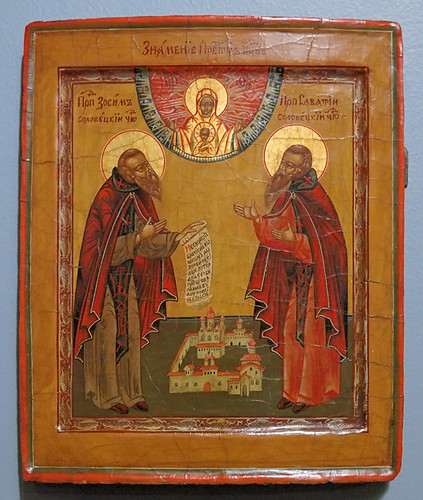
Saints Zosim and Savvatti are depicted on this Russian Orthodox icon, at the Saint Louis University Museum of Art. These Saints founded the Solovetsky monastery on the White Sea in the 15th century.
Wednesday, October 21, 2009
At Dawn
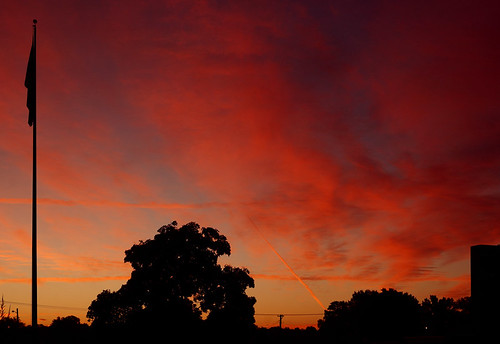
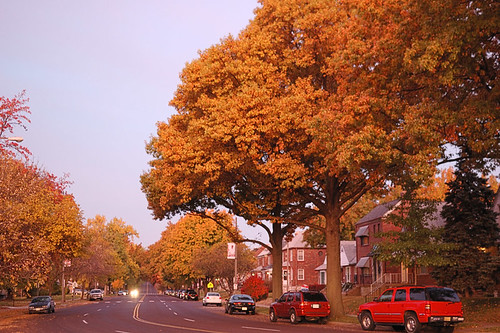
I took the previous two photos just before sunrise this morning. A few minutes after taking the last picture, I saw a large red fox running across the street. A while later, I saw a small bird of prey flying off — normally you don't see these animals in the daytime.

Fall colors here are at their peak.
Monday, October 19, 2009
A Walk Along Grand Boulevard
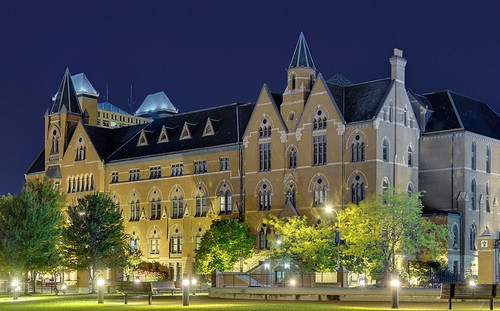
DuBourg Hall of Saint Louis University. Completed in 1888 and designed by Thomas Waryng Walsh, this was the first building on SLU's Midtown campus. The original Gothic interior has been heavily modernized.
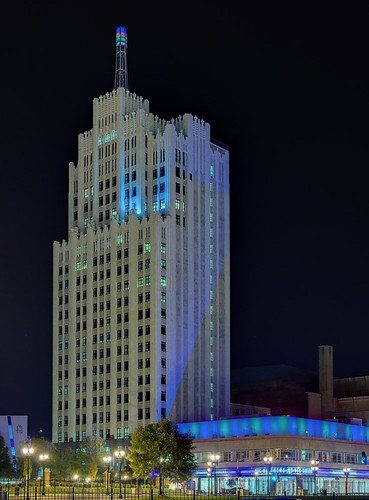
The Continental Life Building, designed by William B. Ittner and completed in 1930, was once a very desirable business address; but with urban decay it was abandoned in 1974. It was restored and reopened in 2001. The beacon atop the building features changing colors.
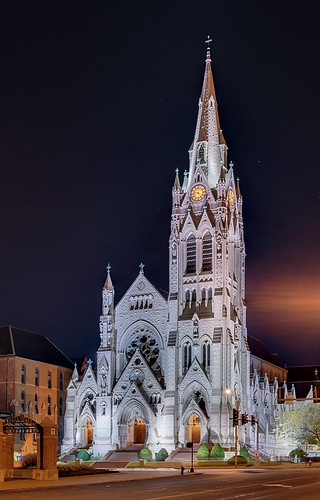
Saint Francis Xavier Church. Construction started in 1883, and like DuBourg Hall, this church was designed by Thomas Walsh, and is modeled after the Cathedral of Saint Coman, in Cobh, Ireland. The interior was reordered in the 1980s.
Due to a severe mix of electric light types in these photos — including monochromatic sodium vapor lights — coupled with camera and post-processing limitations, the colors portrayed in these photos are only approximate at best, and should be taken with a grain of salt.

The Fox Theatre was designed by C. Howard Crane, and opened in 1929, during the Golden Age of Hollywood film. This large theater features an elaborate Burmese-Byzantine hybrid interior. It closed in 1978, and reopened several years later after an extensive reconstruction.
As the colors in this original photo were not even plausible, for the reasons given above, I converted it to black and white. A better photo could be captured during dusk.
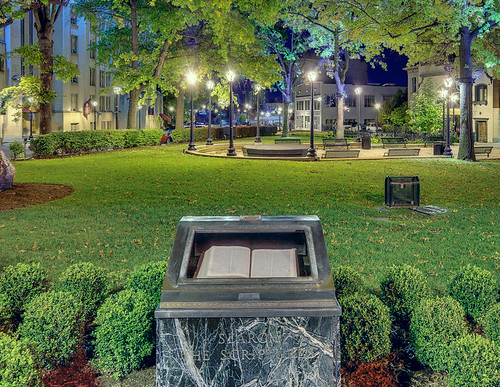
This monument features an open Bible, turned to one of Saint Paul's letters to the Corinthians. It was placed here by Lutherans in 1951. This is in a park opposite from the Fox.
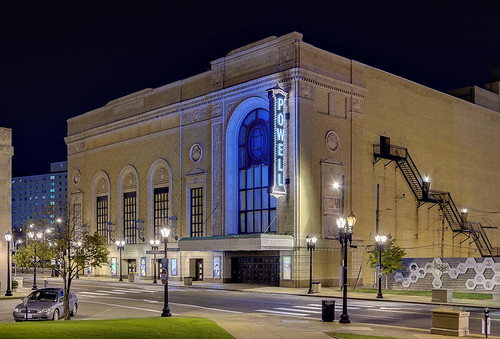
Powell Hall, home of the Saint Louis Symphony Orchestra. This was formerly the Saint Louis Theater, designed by the Chicago firm of Rapp & Rapp, and opening in 1925. It has been the home of the orchestra since 1968. The stained glass window over the entrance depicts Saint Louis IX, King of France.
In the 1920s, Midtown became Saint Louis' premier entertainment district, replacing the old ‘Electric Avenue’ downtown, located at what is now the football stadium. For a 1954 photo of the Midtown theater district, click here.
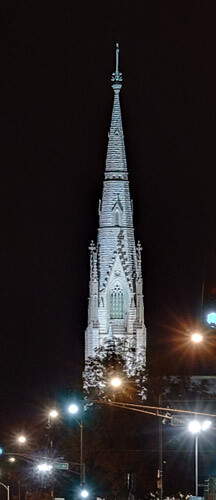
Tower of Saint Alphonsus Liguori Church, also designed by Walsh.
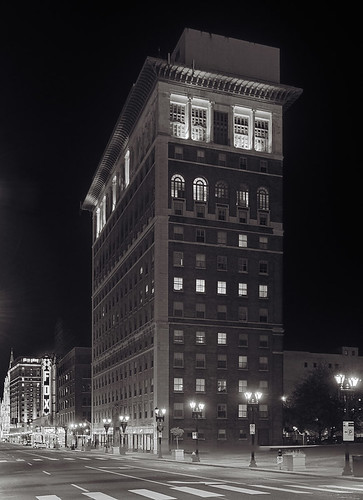
The old University Club Tower, dating from 1917. This is not to be confused with the newer University Club Tower, completed in 1975, which is located in the suburban Saint Louis County community of Richmond Heights. The Club itself folded in 2007 after struggling for a number of years.
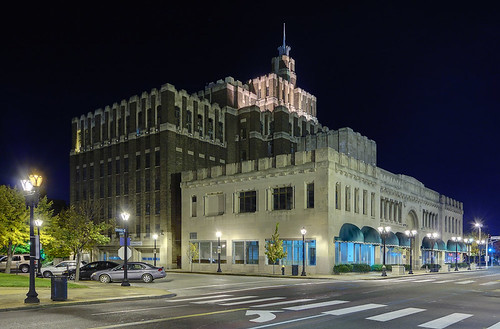
The Carter Carburetor Building, located across the street from Powell Hall. Built in 1928, and originally the home of the Knights of Pythias (a fraternal secret society charted by the U.S. Congress), this building now appears to be vacant. It is also known as the Beaux Arts Building.
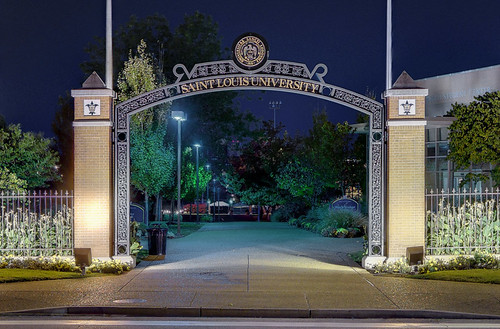
An entrance gateway to Saint Louis University. Decorative gateways and fencing were added to the SLU in recent years to both beautify and secure the campus.
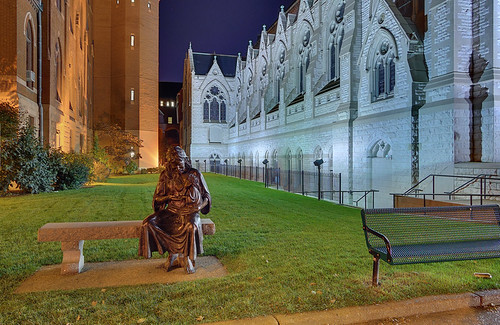
Statue of the Sacred Heart of Jesus, next to Saint Francis Xavier Church. It is entitled Cor ad Cor Loquitur (‘heart speaking to heart’), and is by artist James Michael Maher.
Click here for a map to the area.
Saturday, October 17, 2009
Friday, October 16, 2009

O God,
from the very beginning of time
you commanded the earth to bring forth vegetation
and every fruit of every kind.
You provide the sower with seed and give bread to eat.
Grant, we pray, that this land,
enriched by your bounty and cultivated by human hands,
may be fertile with abundant crops.
Then your people, enriched by the gifts of your goodness,
will praise you unceasingly now and for all ages unending.
Grant this through Christ our Lord.
Amen.
Thursday, October 15, 2009
“The Mystery of Israel and the Church”
Dr. Feingold's continuing lecture series is entitled “The Mystery of Israel and the Church,” and is recorded each Wednesday from Boland Hall at the Cathedral Basilica of Saint Louis, 7-9 p.m. The series is presented by the Association of Hebrew Catholics.
Feast of Saint Teresa of Ávila
“Well, I cannot find, and have never found, any way of comforting such people, except to express great sorrow at their trouble, which, when I see them so miserable, I really do feel. It is useless to argue with them, for they brood over their woes and make up their minds that they are suffering for God's sake, and thus never really understand that it is all due to their own imperfection. And in persons who have made so much progress this is a further mistake; one cannot be surprised if they suffer, though I think this kind of suffering ought to pass quickly. For often it is God's will that His elect should be conscious of their misery and so He withdraws His help from them a little — and no more than that is needed to make us recognize our limitations very quickly. They then realize that this is a way of testing them, for they gain a clear perception of their shortcomings, and sometimes they derive more pain from finding that, in spite of themselves, they are still grieving about earthly things, and not very important things either, than from the matter which is troubling them. This, I think, is a great mercy on the part of God, and even though they are at fault they gain a great deal in humility.”— Saint Teresa of Ávila, Interior Castle, Third Mansion, Chapter II/3
Wednesday, October 14, 2009
"... a rash and impulsive decision" - This Week at Vatican II

View inside Saint Peter's Basilica during Vatican II
From the Very Rev. John T. Myler, Rector of the Cathedral of Saint Peter in Belleville, Illinois, comes a new blog, This Week at Vatican II:
Starting in 2009, the Church begins the observance the 50th anniversary of the Second Vatican Council. Pope John XXIII announced an ecumenical (universal) Council for the Church in January 1959. For the next three years the world's Bishops prepared for the Council -- and Vatican II met in four sessions from 1962 to 1965. Re-live the history of the Council and recall its authentic teaching at this blog, week-by-week (and sometimes day-by-day).http://thisweekatvaticanii.blogspot.com
Reminder - Book Signing at the Washington Missouri Public Library
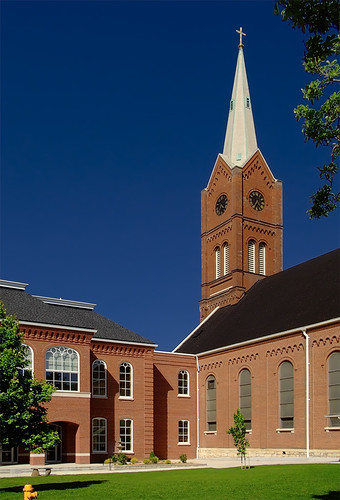
Saint Francis Borgia Church in Washington is featured in the book.
Thursday, October 15th, 2009, 7:00 p.m.
Washington Missouri Public Library
Also featured in the program are authors Thecla and Terrence McCarthy.
Address:
415 Jefferson Street
Washington, Missouri 63090
Cost of the book is $32.95 plus tax. Cash and checks accepted.
You can purchase a copy with credit card here:
Saint Ambrose on the Hill
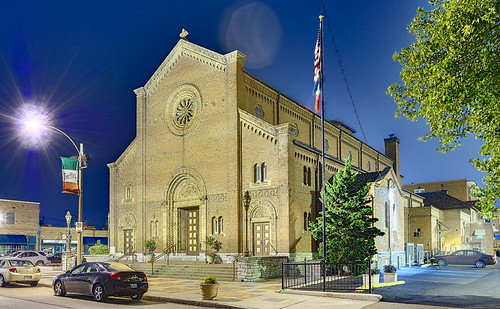
A Photo of Saint Ambrose Church, in the Hill neighborhood of Saint Louis.
I took this photo after giving a talk and book signing at this church — I enjoyed meeting everyone; much thanks! As it was a mild evening, I got the idea that I would take night photos of this charming neighborhood. Alas, it started raining; and drops of water got on the lens, which you can see in this photo.
Tuesday, October 13, 2009
Maryland Plaza
Reminder - Book Signing Tonight at Saint Ambrose
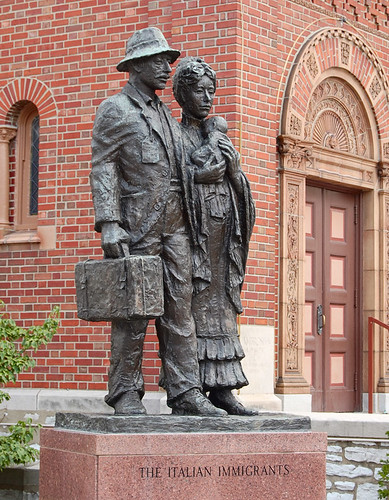
Tuesday, October 13th, 2009, 7:00 p.m.
Saint Ambrose Church, in Saint Louis.
The price of the book is $32.95.
Address:
5130 Wilson Avenue
Saint Louis, Missouri
Five New Saints
Monday, October 12, 2009
Forest 44 at Night
Properties owned by the Missouri Department of Conservation, including this property, are open from 4 a.m. to 10 p.m., giving adventurous souls the opportunity to visit these places during darkness.
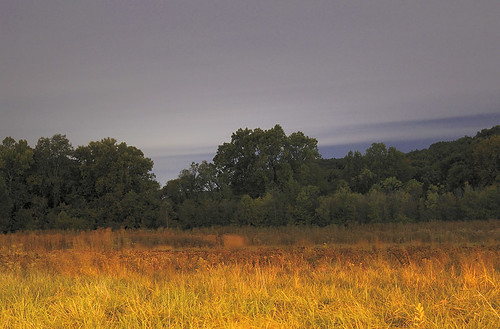
However, on an overcast night like this, it really isn't very dark, due to electric lighting illumining the clouds. It was bright enough to take decent photography. These photos had exposure times varying from fifteen seconds to four minutes.
In the photo above, the lighting from the parking lot illuminated the grasses in the foreground.
Dense forest here was rare in the days before Columbus and European colonization. The Indians used burning to maintain open areas of prairie, a practice that terrified the Europeans; but a mix of forest and grassland attracts a greater variety of wildlife than either habitat alone. The Conservation Department actively maintains the prairie area in the foreground of the above photo.
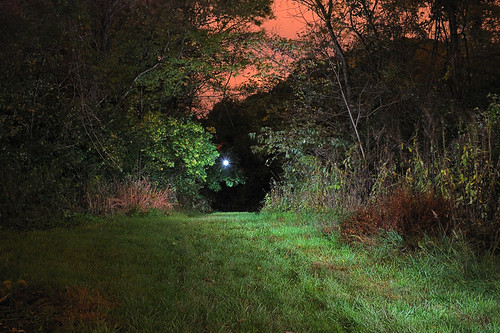
Here I tried to be clever. With my camera fixed on a tripod, and keeping the camera's shutter open for a long period of time, I walked around the area of the photo, setting off a portable flash multiple times to illuminate the vegetation here. Although I attempted to always point the flash away from the camera, once by mistake I did set it off in the direction of the lens, so you can see a bright light in the center of the photo. More than just a gimmick, ‘Strobist’ or ‘Painting with Light’ techniques can create distinctive photos, but it requires careful execution and attention to proper exposure.
The sky was illuminated by surrounding electric lighting, and with my eyes I could see the various colors of the clouds, but I saw the ground and vegetation in only shades of gray and black. But when I set off the flash, the dark gray vegetation, for a moment, was revealed in color. These brief flashes of light didn't harm my night vision much.
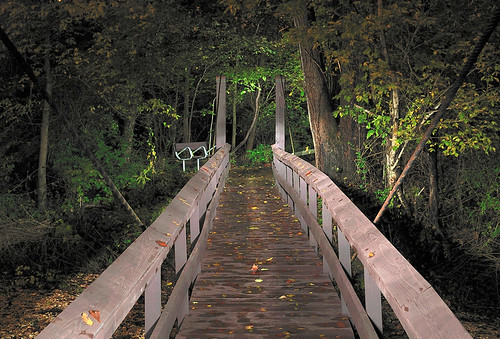
A suspension footbridge over a stream, which is a tributary of Williams Creek. I know of at least five springs within the park, which includes one which is used by an adjacent stable to water the horses, and another with a dense growth of water cress (however, my photos of this spring didn't turn out good).
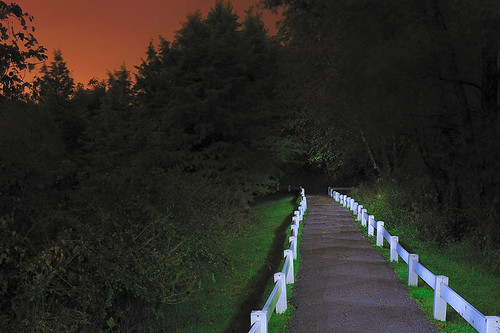
This part of the park is swampy, and the areas on either side of the walkway are perennially muddy or covered with water. In springtime the number of frogs here is tremendous, and the noise they make at dusk is almost deafening.
I was using an antique flash that quickly drained my cheap batteries, so I didn't take any more strobe pictures that evening. But I like the orange sky in this photo.
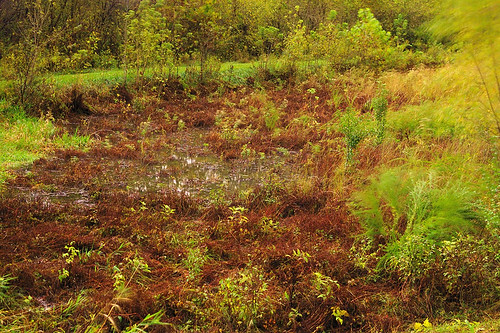
A view of part of a swamp. When I took this photo, an owl was hooting nearby.

A grassy path leads around to the other side of the swamp.

A view of Williams Creek. An obstruction in the creek bed is causing the water to pool a bit. As we had plenty of rain lately, the stream is flowing briskly, but normally the creek at this point is completely dry. Just upstream from here is a low rock ledge, and under normal conditions the water just flows into a crevice under the rocks, disappearing from view and flowing underground.

A view of a very muddy field.
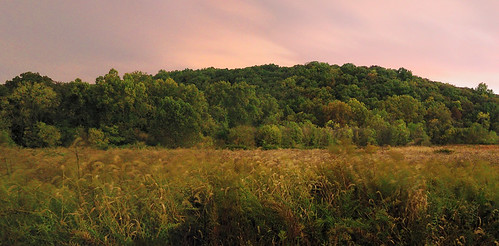
A view of the hills. At this time, it started getting windy and the grasses in the foreground are blurry as a result.
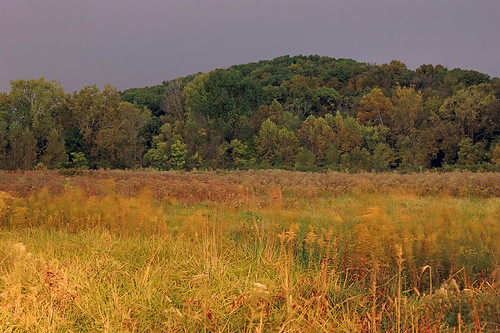
Due to the nice bright sky, these photos were within the normal operating range of my camera. Click here for some of my older photos at this park, which includes two photos where it was really too dark for decent quality.
Click here for a map to the area.


